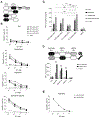Multispecific Targeting with Synthetic Ankyrin Repeat Motif Chimeric Antigen Receptors
- PMID: 31548346
- PMCID: PMC6940018
- DOI: 10.1158/1078-0432.CCR-19-1479
Multispecific Targeting with Synthetic Ankyrin Repeat Motif Chimeric Antigen Receptors
Abstract
Purpose: The outgrowth of antigen-negative variants is a significant challenge for adoptive therapy with T cells that target a single specificity. Chimeric antigen receptors (CAR) are typically designed with one or two scFvs that impart antigen specificity fused to activation and costimulation domains of T-cell signaling molecules. We designed and evaluated the function of CARs with up to three specificities for overcoming tumor escape using Designed Ankyrin Repeat Proteins (DARPins) rather than scFvs for tumor recognition.
Experimental design: A monospecific CAR was designed with a DARPin binder (E01) specific for EGFR and compared with a CAR designed using an anti-EGFR scFv. CAR constructs in which DARPins specific for EGFR, EpCAM, and HER2 were linked together in a single CAR were then designed and optimized to achieve multispecific tumor recognition. The efficacy of CAR-T cells bearing a multispecific DARPin CAR for treating tumors with heterogeneous antigen expression was evaluated in vivo.
Results: The monospecific anti-EGFR E01 DARPin conferred potent tumor regression against EGFR+ targets that was comparable with an anti-EGFR scFv CAR. Linking three separate DARPins in tandem was feasible and in an optimized format generated a single tumor recognition domain that targeted a mixture of heterogeneous tumor cells, each expressing a single antigen, and displayed synergistic activity when tumor cells expressed more than one target antigen.
Conclusions: DARPins can serve as high-affinity recognition motifs for CAR design, and their robust architecture enables linking of multiple binders against different antigens to achieve functional synergy and reduce antigen escape.
©2019 American Association for Cancer Research.
Conflict of interest statement
Disclosure of potential conflicts of interest:
S.R.R. is a founder of Juno Therapeutics, a Celgene company and has served as a scientific advisor to Juno Therapeutics, Adaptive Biotechnologies, Nohla and Cell Medica. AP is a cofounder and shareholder of Molecular Partners AG, which commercializes the DARPin technology. The other authors declare that they have no competing interests.
Figures





Similar articles
-
Combined CD28 and 4-1BB Costimulation Potentiates Affinity-tuned Chimeric Antigen Receptor-engineered T Cells.Clin Cancer Res. 2019 Jul 1;25(13):4014-4025. doi: 10.1158/1078-0432.CCR-18-2559. Epub 2019 Apr 12. Clin Cancer Res. 2019. PMID: 30979735 Free PMC article.
-
Adnectin-Based Design of Chimeric Antigen Receptor for T Cell Engineering.Mol Ther. 2017 Nov 1;25(11):2466-2476. doi: 10.1016/j.ymthe.2017.07.009. Epub 2017 Jul 20. Mol Ther. 2017. PMID: 28784559 Free PMC article.
-
Designed Ankyrin Repeat Proteins as Her2 Targeting Domains in Chimeric Antigen Receptor-Engineered T Cells.Hum Gene Ther. 2017 Sep;28(9):726-736. doi: 10.1089/hum.2017.021. Epub 2017 Jun 22. Hum Gene Ther. 2017. PMID: 28796529 Free PMC article.
-
Alternative target recognition elements for chimeric antigen receptor (CAR) T cells: beyond standard antibody fragments.Cytotherapy. 2024 Jul;26(7):729-738. doi: 10.1016/j.jcyt.2024.02.024. Epub 2024 Mar 2. Cytotherapy. 2024. PMID: 38466264 Review.
-
Chimeric antigen-receptor T-cell therapy for hematological malignancies and solid tumors: Clinical data to date, current limitations and perspectives.Curr Res Transl Med. 2017 Sep;65(3):93-102. doi: 10.1016/j.retram.2017.08.003. Curr Res Transl Med. 2017. PMID: 28988742 Review.
Cited by
-
CAR T-Cells in Multiple Myeloma: State of the Art and Future Directions.Front Oncol. 2020 Jul 28;10:1243. doi: 10.3389/fonc.2020.01243. eCollection 2020. Front Oncol. 2020. PMID: 32850376 Free PMC article. Review.
-
Multispecific drugs herald a new era of biopharmaceutical innovation.Nature. 2020 Apr;580(7803):329-338. doi: 10.1038/s41586-020-2168-1. Epub 2020 Apr 15. Nature. 2020. PMID: 32296187 Review.
-
Beyond CAR-T: The rise of CAR-NK cell therapy in asthma immunotherapy.J Transl Med. 2024 Aug 5;22(1):736. doi: 10.1186/s12967-024-05534-8. J Transl Med. 2024. PMID: 39103889 Free PMC article. Review.
-
Engineered SH3-Derived Sherpabodies Function as a Modular Platform for Targeted T-cell Immunotherapy.Cancer Res. 2025 May 15;85(10):1874-1887. doi: 10.1158/0008-5472.CAN-24-1959. Cancer Res. 2025. PMID: 40029291
-
Anti-CD19 CAR T cells potently redirected to kill solid tumor cells.PLoS One. 2021 Mar 18;16(3):e0247701. doi: 10.1371/journal.pone.0247701. eCollection 2021. PLoS One. 2021. PMID: 33735268 Free PMC article.
References
Publication types
MeSH terms
Substances
Grants and funding
LinkOut - more resources
Full Text Sources
Other Literature Sources
Research Materials
Miscellaneous

